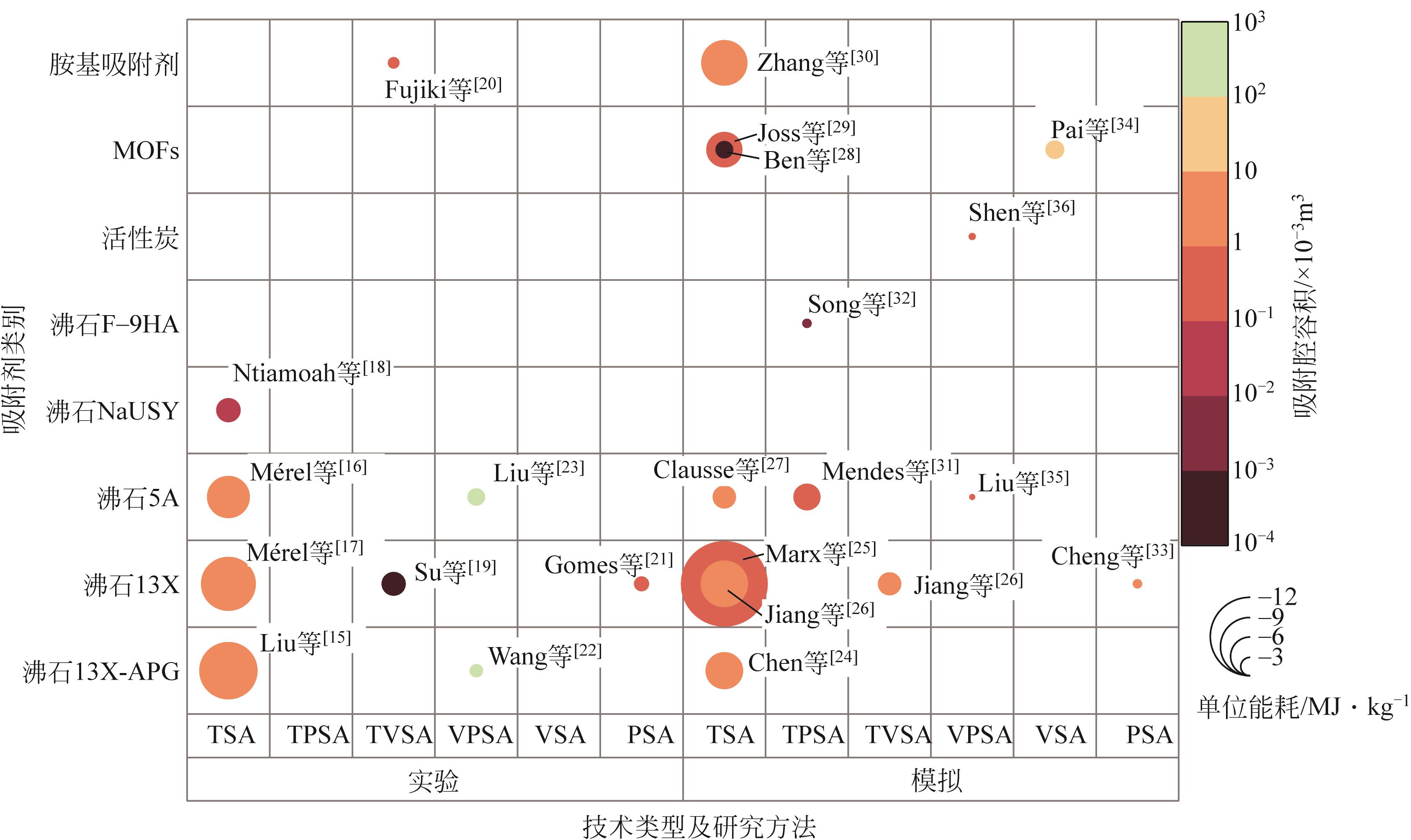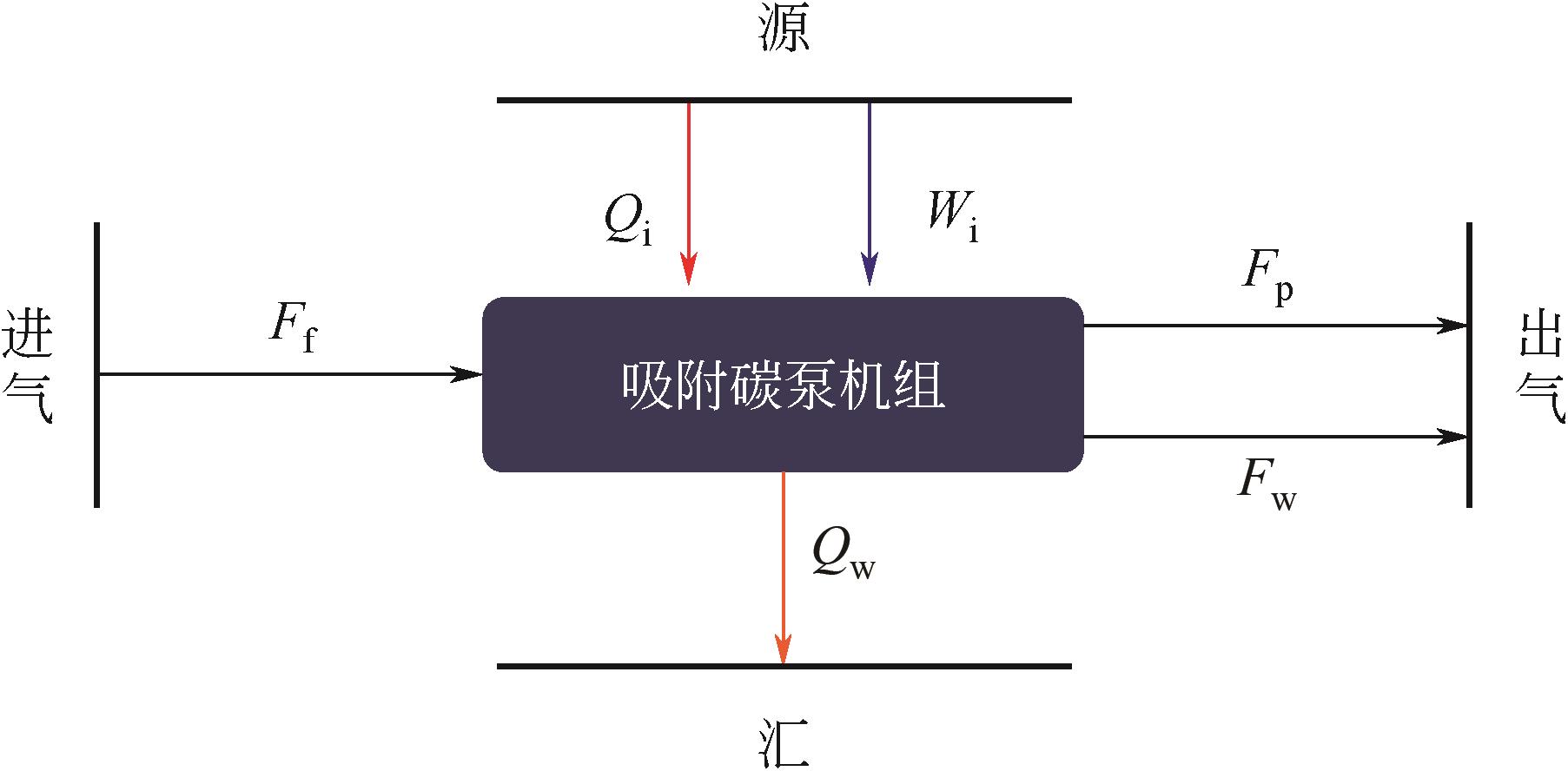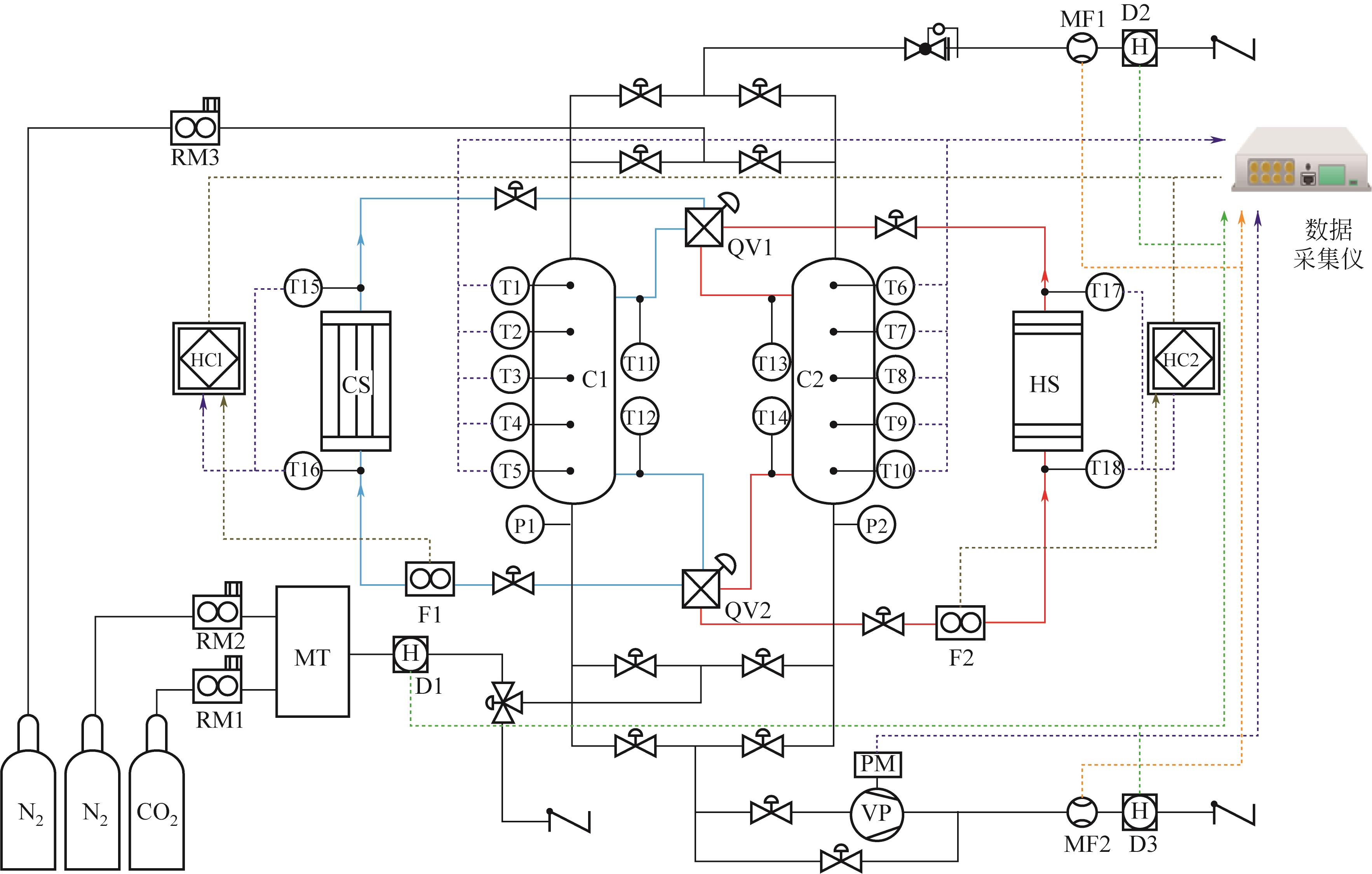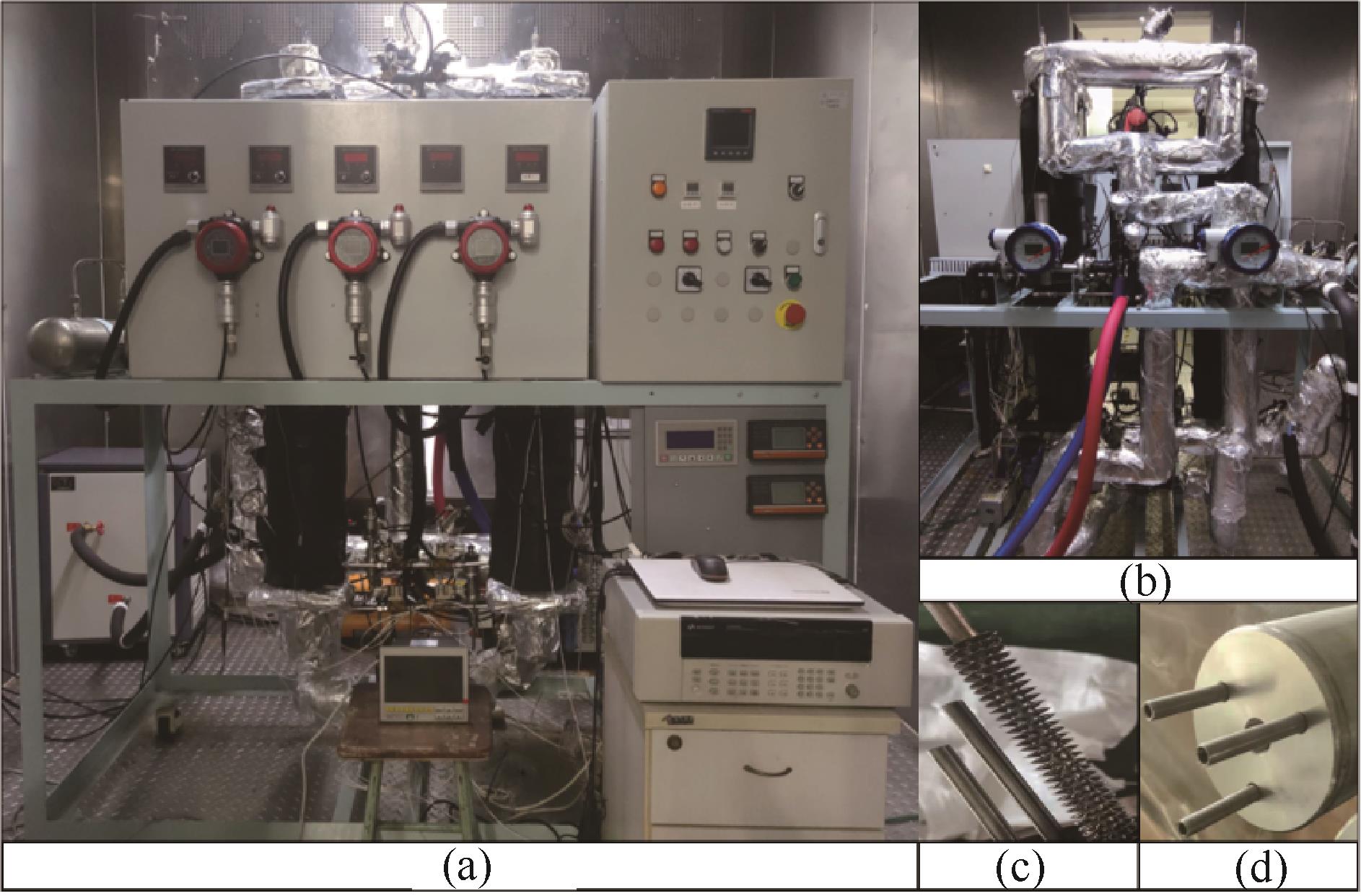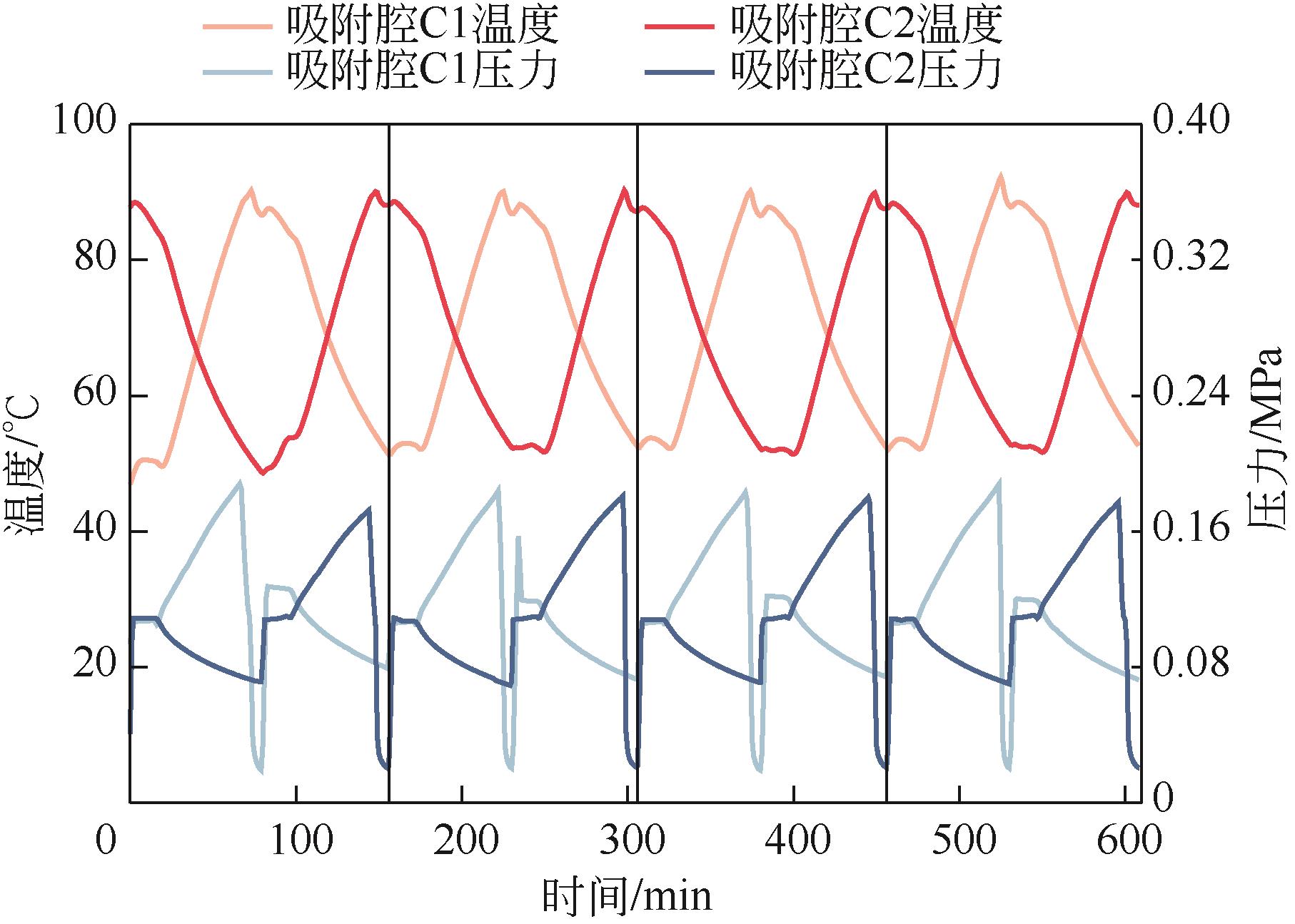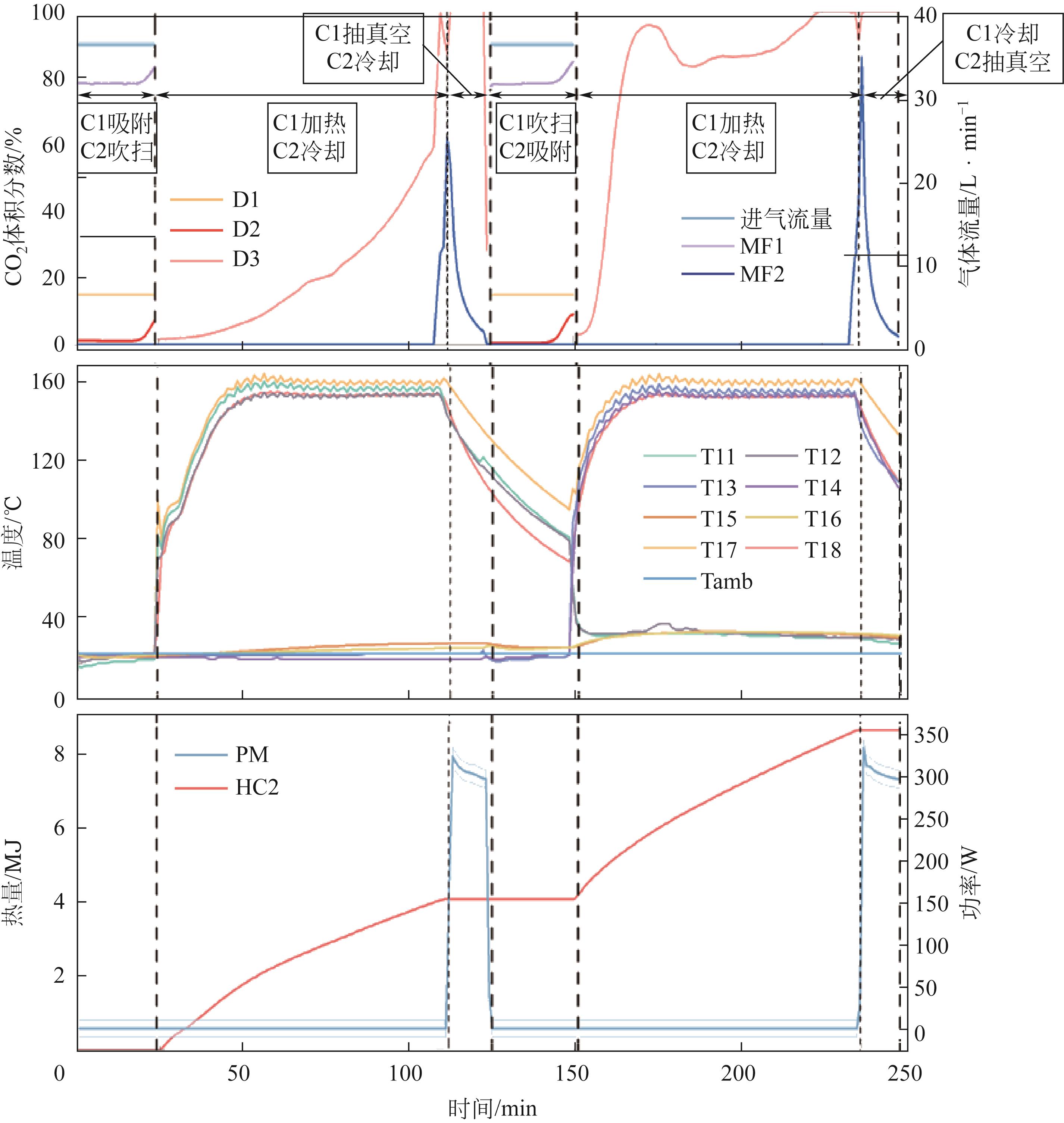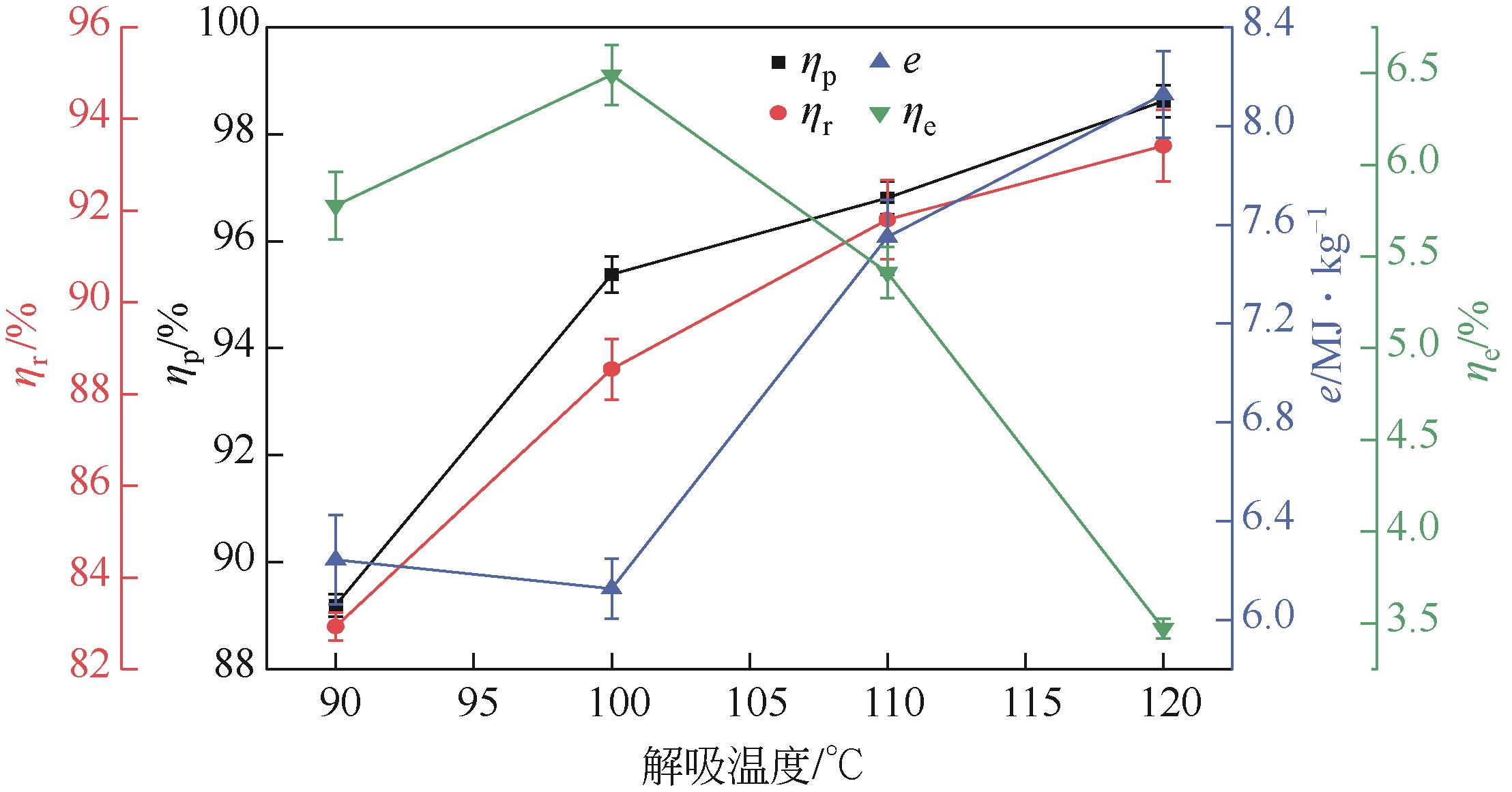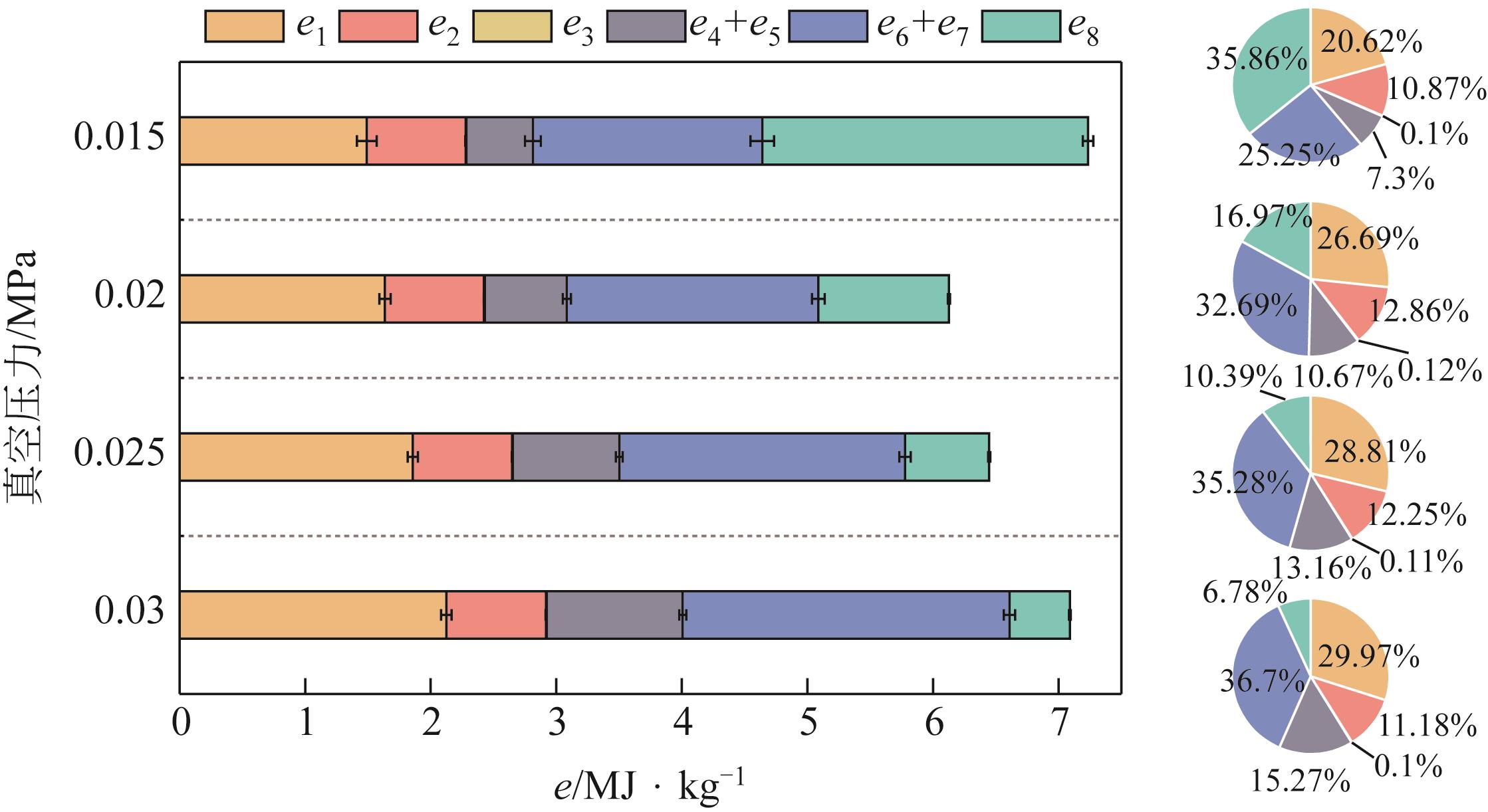Chemical Industry and Engineering Progress ›› 2023, Vol. 42 ›› Issue (7): 3834-3846.DOI: 10.16085/j.issn.1000-6613.2022-1582
• Resources and environmental engineering • Previous Articles Next Articles
Exploration on standardized test scheme and experimental performance of temperature swing adsorption carbon capture unit
BAI Yadi1,2( ), DENG Shuai1,2(
), DENG Shuai1,2( ), ZHAO Ruikai1,2, ZHAO Li1, YANG Yingxia3
), ZHAO Ruikai1,2, ZHAO Li1, YANG Yingxia3
- 1.Key Laboratory of Efficient Utilization of Low and Medium Grade Energy (Tianjin University), Ministry of Education of China, Tianjin 300350, China
2.International Cooperation Research Center of Carbon Capture in Ultra-Low Energy-Consumption, Tianjin 300350, China
3.China Academy of Building Research, Beijing 100013, China
-
Received:2022-08-26Revised:2022-11-15Online:2023-08-14Published:2023-07-15 -
Contact:DENG Shuai
变温吸附碳捕集机组标准化测试方案探讨及性能实验
白亚迪1,2( ), 邓帅1,2(
), 邓帅1,2( ), 赵睿恺1,2, 赵力1, 杨英霞3
), 赵睿恺1,2, 赵力1, 杨英霞3
- 1.天津大学中低温热能高效利用教育部重点实验室,天津 300350
2.天津市超低能耗碳捕集国际联合研究中心,天津 300350
3.中国建筑科学研究院有限公司,北京 100013
-
通讯作者:邓帅 -
作者简介:白亚迪(1998—),男,硕士研究生,研究方向为二氧化碳吸附。E-mail:1571071872@qq.com。 -
基金资助:天津市自然科学基金重点项目(22JCZDJC00540)
CLC Number:
Cite this article
BAI Yadi, DENG Shuai, ZHAO Ruikai, ZHAO Li, YANG Yingxia. Exploration on standardized test scheme and experimental performance of temperature swing adsorption carbon capture unit[J]. Chemical Industry and Engineering Progress, 2023, 42(7): 3834-3846.
白亚迪, 邓帅, 赵睿恺, 赵力, 杨英霞. 变温吸附碳捕集机组标准化测试方案探讨及性能实验[J]. 化工进展, 2023, 42(7): 3834-3846.
share this article
Add to citation manager EndNote|Ris|BibTeX
URL: https://hgjz.cip.com.cn/EN/10.16085/j.issn.1000-6613.2022-1582
| 参考文献 | 技术类型 | 研究方法 | 单位能耗/MJ·kg-1 | e1 | e2 | e3 | e4 | e5 | e6 | e7 | e8 |
|---|---|---|---|---|---|---|---|---|---|---|---|
| Liu等[ | TSA | 实验 | 8.41 | √ | √ | √ | √ | √ | |||
| Ntiamoah等[ | TSA | 实验 | 3.4 | √ | √ | ||||||
| Chen等[ | TSA | 模拟 | 5.36 | √ | √ | √ | √ | ||||
| Marx等[ | TSA | 模拟 | 2.85 | √ | √ | √ | |||||
| TSA | 模拟 | 12.6 | √ | √ | √ | √ | |||||
| Jiang等[ | TSA | 模拟 | 6.76 | √ | √ | √ | |||||
| TVSA | 模拟 | 3.22 | √ | √ | √ | √ | |||||
| Ben-Mansour等[ | TSA | 模拟 | 2.39 | √ | √ | √ | √ |
| 参考文献 | 技术类型 | 研究方法 | 单位能耗/MJ·kg-1 | e1 | e2 | e3 | e4 | e5 | e6 | e7 | e8 |
|---|---|---|---|---|---|---|---|---|---|---|---|
| Liu等[ | TSA | 实验 | 8.41 | √ | √ | √ | √ | √ | |||
| Ntiamoah等[ | TSA | 实验 | 3.4 | √ | √ | ||||||
| Chen等[ | TSA | 模拟 | 5.36 | √ | √ | √ | √ | ||||
| Marx等[ | TSA | 模拟 | 2.85 | √ | √ | √ | |||||
| TSA | 模拟 | 12.6 | √ | √ | √ | √ | |||||
| Jiang等[ | TSA | 模拟 | 6.76 | √ | √ | √ | |||||
| TVSA | 模拟 | 3.22 | √ | √ | √ | √ | |||||
| Ben-Mansour等[ | TSA | 模拟 | 2.39 | √ | √ | √ | √ |
| 进气体积分数 | 进气温度 | 热源温度 | 冷源温度 | 环境温度 | 气体流速 |
|---|---|---|---|---|---|
15% CO2 85% N2 | 25℃ | 160℃ | 25℃ | 25℃ | 根据吸附剂的材质、结构和性能确定:采用颗粒状活性炭时,为0.20~0.60m/s;采用活性炭纤维毡时,为0.10~0.15m/s;采用蜂窝状吸附剂时,为0.70~1.20m/s |
| 进气体积分数 | 进气温度 | 热源温度 | 冷源温度 | 环境温度 | 气体流速 |
|---|---|---|---|---|---|
15% CO2 85% N2 | 25℃ | 160℃ | 25℃ | 25℃ | 根据吸附剂的材质、结构和性能确定:采用颗粒状活性炭时,为0.20~0.60m/s;采用活性炭纤维毡时,为0.10~0.15m/s;采用蜂窝状吸附剂时,为0.70~1.20m/s |
| 能耗项 | 计算公式 | 含义 | 备注 |
|---|---|---|---|
| E1 | 加热过程中吸附剂升温所消耗的能量 | ms为吸附剂质量;cp,s为吸附剂的比热容;Tads和Tdes分别为吸附和解吸温度 | |
| E2 | CO2和N2从吸附剂中脱附时消耗的能量 | ||
| E3 | 解吸出的CO2和N2被加热所消耗的能量 | ||
| E4+E5 | 吸附腔金属壁面升温及其向环境的散热所消耗的能量 | t1为加热时间;qoil为导热介质流量;cp,oil为导热介质比热;ΔT1为吸附腔两端的温差 | |
| E6+E7 | 导热介质输送管道升温及其向环境散热所消耗的能量 | ΔT2为热源两端的温差 | |
| E8 | 真空泵等运行所消耗的能量 | t2为泵工作时间;P为泵功率 |
| 能耗项 | 计算公式 | 含义 | 备注 |
|---|---|---|---|
| E1 | 加热过程中吸附剂升温所消耗的能量 | ms为吸附剂质量;cp,s为吸附剂的比热容;Tads和Tdes分别为吸附和解吸温度 | |
| E2 | CO2和N2从吸附剂中脱附时消耗的能量 | ||
| E3 | 解吸出的CO2和N2被加热所消耗的能量 | ||
| E4+E5 | 吸附腔金属壁面升温及其向环境的散热所消耗的能量 | t1为加热时间;qoil为导热介质流量;cp,oil为导热介质比热;ΔT1为吸附腔两端的温差 | |
| E6+E7 | 导热介质输送管道升温及其向环境散热所消耗的能量 | ΔT2为热源两端的温差 | |
| E8 | 真空泵等运行所消耗的能量 | t2为泵工作时间;P为泵功率 |
| 性能指标所需测量参数 | 纯度 | 回收率 | 比能耗 | 能源效率 |
|---|---|---|---|---|
| 解吸阶段出口处实时气体流量 | √ | √ | √ | √ |
| 吸附阶段进口处的气体流量 | √ | √ | ||
| 气体中实时CO2含量 | √ | √ | √ | √ |
| 进出机组及吸附腔的导热介质温度 | √ | √ | ||
| 环境温度 | √ | √ | ||
| 吸附剂温度 | √ | √ | ||
| 导热介质流量 | √ | √ | ||
| 泵实时功率 | √ | √ | ||
| 气体吸附热 | Δ | Δ | ||
| 相应温度下气体的焓 | ○ | ○ | ||
| 分离前后CO2相应的熵变和焓变 | ○ |
| 性能指标所需测量参数 | 纯度 | 回收率 | 比能耗 | 能源效率 |
|---|---|---|---|---|
| 解吸阶段出口处实时气体流量 | √ | √ | √ | √ |
| 吸附阶段进口处的气体流量 | √ | √ | ||
| 气体中实时CO2含量 | √ | √ | √ | √ |
| 进出机组及吸附腔的导热介质温度 | √ | √ | ||
| 环境温度 | √ | √ | ||
| 吸附剂温度 | √ | √ | ||
| 导热介质流量 | √ | √ | ||
| 泵实时功率 | √ | √ | ||
| 气体吸附热 | Δ | Δ | ||
| 相应温度下气体的焓 | ○ | ○ | ||
| 分离前后CO2相应的熵变和焓变 | ○ |
| 参数 | 数值 | 参数 | 数值 |
|---|---|---|---|
| 吸附腔高度/mm | 1100 | 翅片间距/mm | 5 |
| 吸附腔外径/mm | 100 | 翅片厚度/mm | 1 |
| 吸附腔壁厚/mm | 5 | 管路外径/mm | 12 |
| 换热管外径/mm | 12 | 管路壁厚/mm | 1 |
| 换热管壁厚/mm | 1 | 每腔吸附剂填充量/kg | 5 |
| 翅片高度/mm | 7 |
| 参数 | 数值 | 参数 | 数值 |
|---|---|---|---|
| 吸附腔高度/mm | 1100 | 翅片间距/mm | 5 |
| 吸附腔外径/mm | 100 | 翅片厚度/mm | 1 |
| 吸附腔壁厚/mm | 5 | 管路外径/mm | 12 |
| 换热管外径/mm | 12 | 管路壁厚/mm | 1 |
| 换热管壁厚/mm | 1 | 每腔吸附剂填充量/kg | 5 |
| 翅片高度/mm | 7 |
| 测量位置 | 测试参数 | 测试设备 | 准确度 |
|---|---|---|---|
| T1~T10 | 温度/℃ | K型热电偶 | ±0.75%RDG |
| T11~T18 | Pt100 | ±0.25%RDG | |
| P1、P2 | 压力/MPa | 压力传感器 | ±1%RDG |
| HC1、HC2 | 冷/热量/MJ | 热量积算仪 | ±0.2%RDG |
| PM | 功率/W | 功率表 | ±0.4%RDG +±0.1%F.S. |
| MF1、MF2 | 气体流量/L·min-1 | 热式质量流量计 | ±0.5%RDG +±0.3%F.S. |
| RM1、RM2、RM3 | 带流量调节功能的流量计 | ||
| D1、D2、D3 | CO2体积分数/% | CO2检测仪 | ≤±1%F.S. |
| 测量位置 | 测试参数 | 测试设备 | 准确度 |
|---|---|---|---|
| T1~T10 | 温度/℃ | K型热电偶 | ±0.75%RDG |
| T11~T18 | Pt100 | ±0.25%RDG | |
| P1、P2 | 压力/MPa | 压力传感器 | ±1%RDG |
| HC1、HC2 | 冷/热量/MJ | 热量积算仪 | ±0.2%RDG |
| PM | 功率/W | 功率表 | ±0.4%RDG +±0.1%F.S. |
| MF1、MF2 | 气体流量/L·min-1 | 热式质量流量计 | ±0.5%RDG +±0.3%F.S. |
| RM1、RM2、RM3 | 带流量调节功能的流量计 | ||
| D1、D2、D3 | CO2体积分数/% | CO2检测仪 | ≤±1%F.S. |
| 1 | 新华社. 中共中央 国务院印发《国家标准化发展纲要》[EB/OL]. (2021-10-10). . |
| 2 | 国家市场监管总局. 加快推进“双碳”标准化工作国家碳达峰碳中和标准化总体组成立[EB/OL]. (2022-03-04). . |
| 3 | 国家市场监管总局. 关于印发贯彻实施《国家标准化发展纲要》行动计划的通知[EB/OL]. (2022-07-08). . |
| 4 | 国家能源局. 关于印发《能源碳达峰碳中和标准化提升行动计划》的通知[EB/OL]. (2022-09-20). . |
| 5 | International Energy Agency. CCUS in Clean Energy Transitions[R]. Paris: IEA, 2020. https://www.iea.org/reports/ccus-in-clean-energy-transitions. |
| 6 | 中华人民共和国住房和城乡建设部, 国家市场监督管理总局. 烟气二氧化碳捕集纯化工程设计标准: [S]. 北京: 中国计划出版社, 2018. |
| Ministry of Housing and Urban-Rural Development of the People’s Republic of China, State Administration for Market Regulation. Standard for design of carbon dioxide capture and purification engineering for flue gas: [S]. Beijing: China Planning Press, 2018. | |
| 7 | 中华人民共和国工业和信息化部. 燃煤烟气二氧化碳捕集装备: [S]. 北京: 机械工业出版社, 2016. |
| Ministry of Industry and Information of the People’s Republic of China. Carbon dioxide capture equipment of coal-fired flue gas: [S]. Beijing: China Machine Press, 2016. | |
| 8 | 中华人民共和国工业和信息化部. 燃煤烟气碳捕集装置调试规范: [S]. 北京: 机械工业出版社, 2016. |
| Ministry of Industry and Information of the People’s Republic of China. Commissioning specification for coal-fired flue gas carbon dioxide capture equipment: [S]. Beijing: China Machine Press, 2016. | |
| 9 | 中华人民共和国工业和信息化部. 燃煤烟气碳捕集装置运行规范: [S]. 北京: 机械工业出版社, 2016. |
| Ministry of Industry and Information of the People’s Republic of China. Operation specification for coal-fired flue gas carbon dioxide capture equipment: [S]. Beijing: China Machine Press, 2016. | |
| 10 | 中国环境科学学会. 二氧化碳捕集利用与封存术语: T/CSES 41—2021 [S]. |
| Chinese Society For Environmental Sciences. Terms of carbon dioxide capture, utilization and storage (CCUS): T/CSES 41—2021 [S]. | |
| 11 | 中国华能集团有限公司.我国首个碳捕集领域国际标准正式立项[EB/OL]. (2022-05-18). . |
| China Huaneng Group Co., Ltd. China’s first international standard in the field of carbon capture was officially established[EB/OL]. (2022-05-18). . | |
| 12 | 冯雷, 陆成宽. 国家能源集团在碳捕集领域牵头制定的国家标准通过立项[EB/OL]. (2022-08-17). . |
| FENG Lei, LU Chengkuan. National standards developed by National Energy Group in the field of carbon capture have been approved[EB/OL]. (2022-08-17). . | |
| 13 | 朱炫灿, 葛天舒, 吴俊晔, 等. 吸附法碳捕集技术的规模化应用和挑战[J]. 科学通报, 2021, 66(22): 2861-2877. |
| ZHU Xuancan, GE Tianshu, WU Junye, et al. Large-scale applications and challenges of adsorption-based carbon capture technologies[J]. Chinese Science Bulletin, 2021, 66(22): 2861-2877. | |
| 14 | LIU Rushuai, SHI Xiaodong, WANG Chengtong, et al. Advances in post-combustion CO2 capture by physical adsorption: From materials innovation to separation practice[J]. ChemSusChem, 2021, 14(6): 1428-1471. |
| 15 | LIU Bowen, LIAN Yahui, LI Shuangjun, et al. Experimental investigation on separation and energy-efficiency performance of temperature swing adsorption system for CO2 capture[J]. Separation and Purification Technology, 2019, 227: 115670. |
| 16 | MÉREL J, CLAUSSE M, MEUNIER F. Carbon dioxide capture by indirect thermal swing adsorption using 13X zeolite[J]. Environmental Progress, 2006, 25(4): 327-333. |
| 17 | MEREL J, CLAUSSE M, MEUNIER F. Experimental investigation on CO2 post-combustion capture by indirect thermal swing adsorption using 13X and 5A zeolites[J]. Industrial & Engineering Chemistry Research, 2008, 47(1): 209-215. |
| 18 | NTIAMOAH A, LING Jianghua, XIAO P, et al. CO2 capture by temperature swing adsorption: Use of hot CO2-rich gas for regeneration[J]. Industrial & Engineering Chemistry Research, 2016, 55(3): 703-713. |
| 19 | SU Fengsheng, LU Chungsying. CO2 capture from gas stream by zeolite 13X using a dual-column temperature/vacuum swing adsorption[J]. Energy & Environmental Science, 2012, 5(10): 9021-9027. |
| 20 | FUJIKI J, CHOWDHURY F A, YAMADA H, et al. Highly efficient post-combustion CO2 capture by low-temperature steam-aided vacuum swing adsorption using a novel polyamine-based solid sorbent[J]. Chemical Engineering Journal, 2017, 307: 273-282. |
| 21 | GOMES V G, YEE K W K. Pressure swing adsorption for carbon dioxide sequestration from exhaust gases[J]. Separation and Purification Technology, 2002, 28(2): 161-171. |
| 22 | WANG Lu, YANG Ying, SHEN Wenlong, et al. Experimental evaluation of adsorption technology for CO2 capture from flue gas in an existing coal-fired power plant[J]. Chemical Engineering Science, 2013, 101: 615-619. |
| 23 | LIU Zhen, WANG Lu, KONG Xiangming, et al. Onsite CO2 capture from flue gas by an adsorption process in a coal-fired power plant[J]. Industrial & Engineering Chemistry Research, 2012, 51(21): 7355-7363. |
| 24 | CHEN Lijin, DENG Shuai, ZHAO Ruikai, et al. Temperature swing adsorption for CO2 capture: Thermal design and management on adsorption bed with single-tube/three-tube internal heat exchanger[J]. Applied Thermal Engineering, 2021, 199: 117538. |
| 25 | MARX D, JOSS L, HEFTI M, et al. Temperature swing adsorption for postcombustion CO2 capture: Single- and multicolumn experiments and simulations[J]. Industrial & Engineering Chemistry Research, 2016, 55(5): 1401-1412. |
| 26 | JIANG Nan, SHEN Yuanhui, LIU Bing, et al. CO2 capture from dry flue gas by means of VPSA, TSA and TVSA[J]. Journal of CO2 Utilization, 2020, 35: 153-168. |
| 27 | CLAUSSE M, MEREL J, MEUNIER F. Numerical parametric study on CO2 capture by indirect thermal swing adsorption[J]. International Journal of Greenhouse Gas Control, 2011, 5(5): 1206-1213. |
| 28 | BEN-MANSOUR R, QASEM N A A. An efficient temperature swing adsorption (TSA) process for separating CO2 from CO2/N2 mixture using Mg-MOF-74[J]. Energy Conversion and Management, 2018, 156: 10-24. |
| 29 | JOSS L, HEFTI M, BJELOBRK Z, et al. On the potential of phase-change adsorbents for CO2 capture by temperature swing adsorption[J]. Energy Procedia, 2017, 114: 2271-2278. |
| 30 | ZHANG Wenbin, LIU Hao, SUN Chenggong, et al. Capturing CO2 from ambient air using a polyethyleneimine-silica adsorbent in fluidized beds[J]. Chemical Engineering Science, 2014, 116: 306-316. |
| 31 | MENDES P A P, RIBEIRO A M, GLEICHMANN K, et al. Separation of CO2/N2 on binderless 5A zeolite[J]. Journal of CO2 Utilization, 2017, 20: 224-233. |
| 32 | SONG Chunfeng, KANSHA Y, FU Qian, et al. Reducing energy consumption of advanced PTSA CO2 capture process― Experimental and numerical study[J]. Journal of the Taiwan Institute of Chemical Engineers, 2016, 64: 69-78. |
| 33 | CHENG Chuyun, Chia Chen KUO, YANG Mingwei, et al. CO2 capture from flue gas of a coal-fired power plant using three-bed PSA process[J]. Energies, 2021, 14(12): 3582. |
| 34 | PAI K N, BABOOLAL J D, SHARP D A, et al. Evaluation of diamine-appended metal-organic frameworks for post-combustion CO2 capture by vacuum swing adsorption[J]. Separation and Purification Technology, 2019, 211: 540-550. |
| 35 | LIU Zhen, GRANDE C A, LI Ping, et al. Multi-bed vacuum pressure swing adsorption for carbon dioxide capture from flue gas[J]. Separation and Purification Technology, 2011, 81(3): 307-317. |
| 36 | SHEN Chunzhi, LIU Zhen, LI Ping, et al. Two-stage VPSA process for CO2 capture from flue gas using activated carbon beads[J]. Industrial & Engineering Chemistry Research, 2012, 51(13): 5011-5021. |
| 37 | WANG Lu, LIU Zhen, LI Ping, et al. Experimental and modeling investigation on post-combustion carbon dioxide capture using zeolite 13X-APG by hybrid VTSA process[J]. Chemical Engineering Journal, 2012, 197: 151-161. |
| 38 | JUNG Wonho, PARK Sunghyun, LEE Kwang Soon, et al. Rapid thermal swing adsorption process in multi-beds scale with sensible heat recovery for continuous energy-efficient CO2 capture[J]. Chemical Engineering Journal, 2020, 392: 123656. |
| 39 | ZHAO Ruikai, ZHAO Li, WANG Shengping, et al. Solar-assisted pressure-temperature swing adsorption for CO2 capture: Effect of adsorbent materials[J]. Solar Energy Materials and Solar Cells, 2018, 185: 494-504. |
| 40 | JIANG L, ROSKILLY A P, WANG R Z. Performance exploration of temperature swing adsorption technology for carbon dioxide capture[J]. Energy Conversion and Management, 2018, 165: 396-404. |
| 41 | MULGUNDMATH V, TEZEL F H. Optimisation of carbon dioxide recovery from flue gas in a TPSA system[J]. Adsorption, 2010, 16(6): 587-598. |
| 42 | Mai BUI, ADJIMAN C S, BARDOW A, et al. Carbon capture and storage (CCS): The way forward[J]. Energy & Environmental Science, 2018, 11(5): 1062-1176. |
| 43 | YOUNG J, GARCÍA-DÍEZ E, GARCIA S, et al. The impact of binary water-CO2 isotherm models on the optimal performance of sorbent-based direct air capture processes[J]. Energy & Environmental Science. 2021, 14(10): 5377-5394. |
| 44 | CHEN Lijin, DENG Shuai, ZHAO Ruaikai, et al. The thermodynamics-based benchmarking analysis on energy-efficiency performance of CO2 capture technology: Temperature swing adsorption as case study[J]. Energy Technology, 2021, 9(1): 2000756. |
| 45 | 石文星, 杨子旭, 王宝龙. 对我国空气源热泵室外名义工况分区的思考[J]. 制冷学报, 2019, 40(5): 1-12. |
| SHI Wenxing, YANG Zixu, WANG Baolong. Division of outdoor nominal condition of air source heat pumps in China[J]. Journal of Refrigeration, 2019, 40(5): 1-12. | |
| 46 | 辛月. 燃煤电厂烟气余热梯级利用降低碳捕集成本[D]. 大连: 大连理工大学, 2017. |
| XIN Yue. Cascade utilization of flue gas waste heat in coal-fired power plant to reduce the cost of carbon capture[D]. Dalian: Dalian University of Technology, 2017. | |
| 47 | 国家市场监督管理总局, 国家标准化管理委员会. 低环境温度空气源热泵(冷水)机组 第1部分:工业或商业用及类似用途的热泵(冷水)机组: [S]. 北京: 中国标准出版社, 2020. |
| State Administration for Market Regulation, Standardization Administration of the People’s Republic of China. Low ambient temperature air source heat pump(water chilling)packages—Part 1: Heat pump (water chilling)packages for industrial & commercial and similar application: [S]. Beijing: Standards Press of China, 2020. | |
| 48 | ZHANG Yingying, JI Xiaoyan, LU Xiaohua. Energy consumption analysis for CO2 separation from gas mixtures[J]. Applied Energy, 2014, 130: 237-243. |
| 49 | ZHAO Ruikai, DENG Shuai, LIU Yinan, et al. Carbon pump: Fundamental theory and applications[J]. Energy, 2017, 119: 1131-1143. |
| 50 | JIANG L, GONZALEZ-DIAZ A, LING-CHIN J, et al. Post-combustion CO2 capture from a natural gas combined cycle power plant using activated carbon adsorption[J]. Applied Energy, 2019, 245: 1-15. |
| 51 | SIEGELMAN R L, KIM E J, LONG J R. Porous materials for carbon dioxide separations[J]. Nature Materials, 2021, 20 (8): 1060-1072. |
| 52 | 中华人民共和国环境保护部. 大气污染治理工程技术导则: [S]. 北京: 中国环境科学出版社, 2011. |
| Ministry of Environmental Protection of the People’s Republic of China. Technical guidelines for air pollution control projects: [S]. Beijing: China Environment Science Press, 2011. | |
| 53 | 国家市场监督管理总局, 国家标准化管理委员会. 能量系统㶲分析技术导则: [S]. 北京: 中国标准出版社, 2021. |
| State Administration for Market Regulation, Standardization Administration of the People’s Republic of China. Technical guidelines for exergy analysis in energy systems: [S]. Beijing: Standards Press of China, 2021. | |
| 54 | COLEMAN H W, STEELE W G JR. Experimentation, validation, and uncertainty analysis for engineers[M]. Hoboken, NJ, USA: John Wiley & Sons, Inc., 2009. |
| 55 | Sung Ho JO, PARK Young Cheol, MOON Jong Ho, et al. Heat integration of KIERDRY process with a power plant using gPROMS[J]. Energy Procedia, 2017, 114: 6660-6665. |
| 56 | WU Kailong, DENG Shuai, LI Shuangjun, et al. Preliminary experimental study on the performance of CO2 capture prototype based on temperature swing adsorption (TSA)[J]. Carbon Capture Science & Technology, 2022, 2: 100035. |
| [1] | DAI Huantao, CAO Lingyu, YOU Xinxiu, XU Haoliang, WANG Tao, XIANG Wei, ZHANG Xueyang. Adsorption properties of CO2 on pomelo peel biochar impregnated by lignin [J]. Chemical Industry and Engineering Progress, 2023, 42(S1): 356-363. |
| [2] | CHEN Chongming, CHEN Qiu, GONG Yunqian, CHE Kai, YU Jinxing, SUN Nannan. Research progresses on zeolite-based CO2 adsorbents [J]. Chemical Industry and Engineering Progress, 2023, 42(S1): 411-419. |
| [3] | WANG Shengyan, DENG Shuai, ZHAO Ruikai. Research progress on carbon dioxide capture technology based on electric swing adsorption [J]. Chemical Industry and Engineering Progress, 2023, 42(S1): 233-245. |
| [4] | YANG Ying, HOU Haojie, HUANG Rui, CUI Yu, WANG Bing, LIU Jian, BAO Weiren, CHANG Liping, WANG Jiancheng, HAN Lina. Coal tar phenol-based carbon nanosphere prepared by Stöber method for adsorption of CO2 [J]. Chemical Industry and Engineering Progress, 2023, 42(9): 5011-5018. |
| [5] | LI Lanyu, HUANG Xinye, WANG Xiaonan, QIU Tong. Reflection and prospects on the intelligent transformation of chemical engineering research [J]. Chemical Industry and Engineering Progress, 2023, 42(7): 3325-3330. |
| [6] | LI Ruolin, HE Shaolin, YUAN Hongying, LIU Boyue, JI Dongli, SONG Yang, LIU Bo, YU Jiqing, XU Yingjun. Effect of in-situ pyrolysis on physical properties of oil shale and groundwater quality [J]. Chemical Industry and Engineering Progress, 2023, 42(6): 3309-3318. |
| [7] | WANG Jiuheng, RONG Nai, LIU Kaiwei, HAN Long, SHUI Taotao, WU Yan, MU Zhengyong, LIAO Xuqing, MENG Wenjia. Enhanced CO2 capture performance and strength of cellulose-templated CaO-based pellets with steam reactivation [J]. Chemical Industry and Engineering Progress, 2023, 42(6): 3217-3225. |
| [8] | LU Shijian, ZHANG Yuanyuan, WU Wenhua, YANG Fei, LIU Ling, KANG Guojun, LI Qingfang, CHEN Hongfu, WANG Ning, WANG Feng, ZHANG Juanjuan. Health risk assessment of nitrosamine pollutant diffusion in a million ton CO2 capture project [J]. Chemical Industry and Engineering Progress, 2023, 42(6): 3209-3216. |
| [9] | GU Shiya, DONG Yachao, LIU Linlin, ZHANG Lei, ZHUANG Yu, DU Jian. Design and optimization of pipeline system for carbon capture considering intermediate nodes [J]. Chemical Industry and Engineering Progress, 2023, 42(6): 2799-2808. |
| [10] | SANG Wei, TANG Jianfeng, HUA Yihuai, CHEN Jie, SUN Peiyuan, XU Yifei. Effects of physical solvent and amine properties on the performance of biphasic solvent [J]. Chemical Industry and Engineering Progress, 2023, 42(4): 2151-2159. |
| [11] | SHANG Yu, XIAO Man, CUI Qiufang, TU Te, YAN Shuiping. Recovery characteristics of PVDF/BN-OH flat composite membrane for waste heat of hot stripped gas in CO2 capture process [J]. Chemical Industry and Engineering Progress, 2023, 42(3): 1618-1628. |
| [12] | KONG Xiangru, ZHANG Xiaoyang, SUN Pengxiang, CUI Lin, DONG Yong. Research progress of solid porous materials for direct CO2 capture from air [J]. Chemical Industry and Engineering Progress, 2023, 42(3): 1471-1483. |
| [13] | CHEN Jiakun, TANG Jian, XIA Heng, QIAO Junfei. Numerical simulation of dioxin emission concentration in grate furnace incineration processes for municipal solid waste [J]. Chemical Industry and Engineering Progress, 2023, 42(2): 1061-1072. |
| [14] | DU Tao, MA Jinwei, CHEN Qianqian, FANG Hao, CHEN Bingzhang, CHEN Houren. Comparison test and numerical simulation analysis of PV/T module composite cooling mode [J]. Chemical Industry and Engineering Progress, 2023, 42(2): 722-730. |
| [15] | LI Yaxia, HAN Zemin, WANG Kai, ZHANG Ping, ZHANG Li, ZHANG Jing. Analysis of heat transfer enhancing performance in helical channel by jet at different positions [J]. Chemical Industry and Engineering Progress, 2023, 42(1): 128-137. |
| Viewed | ||||||
|
Full text |
|
|||||
|
Abstract |
|
|||||
